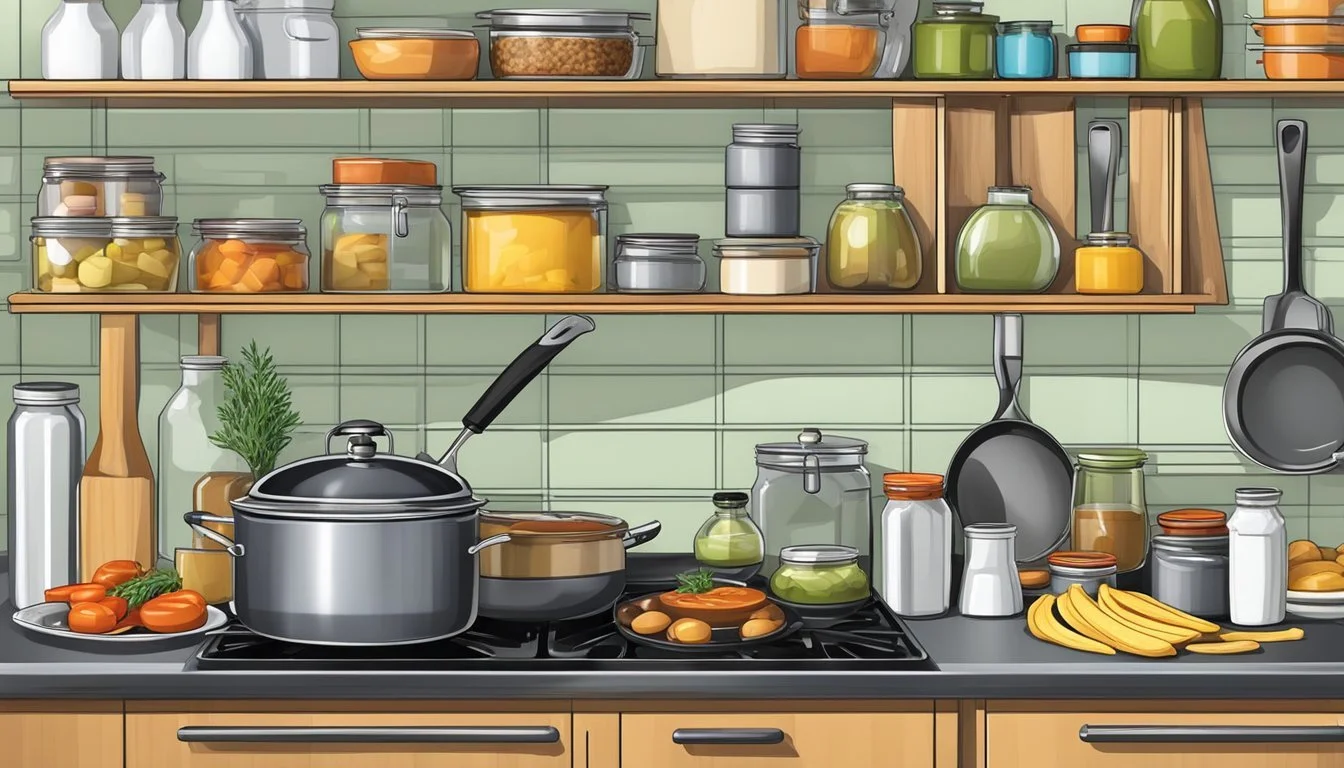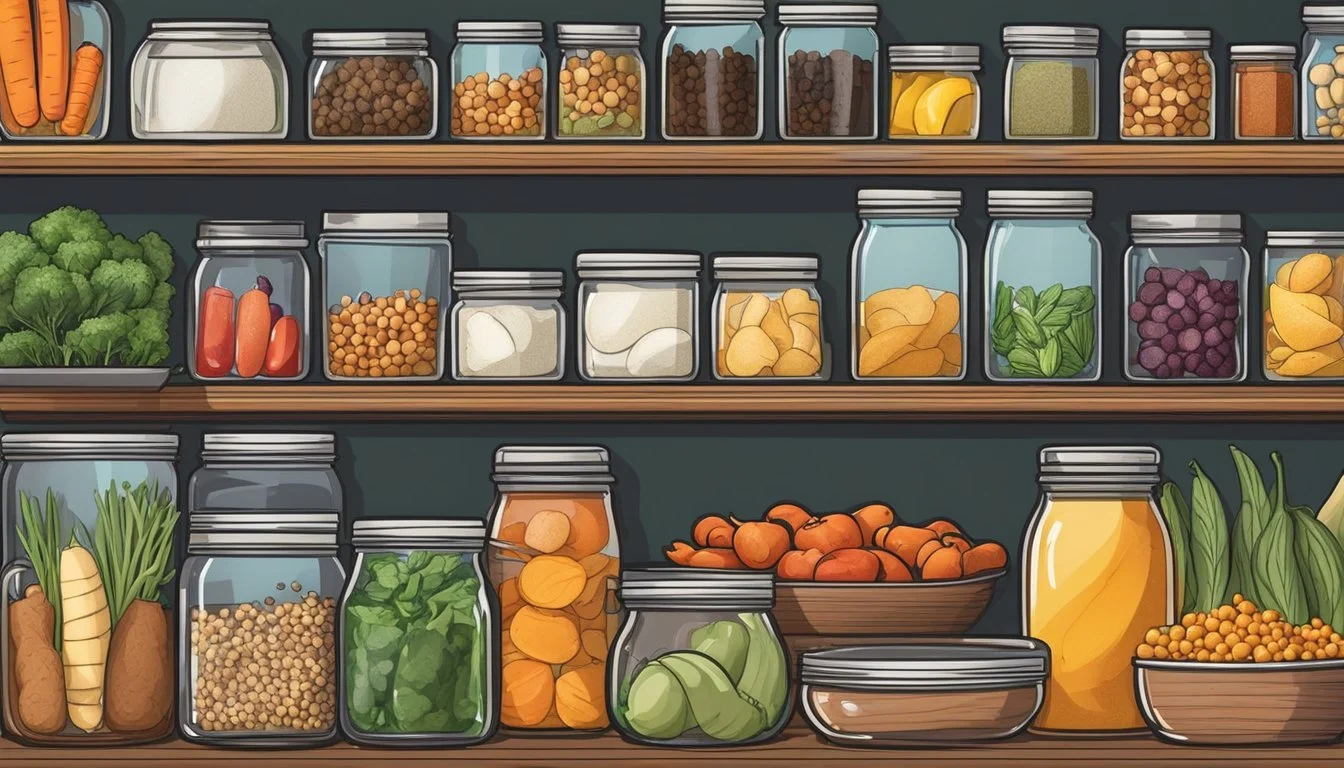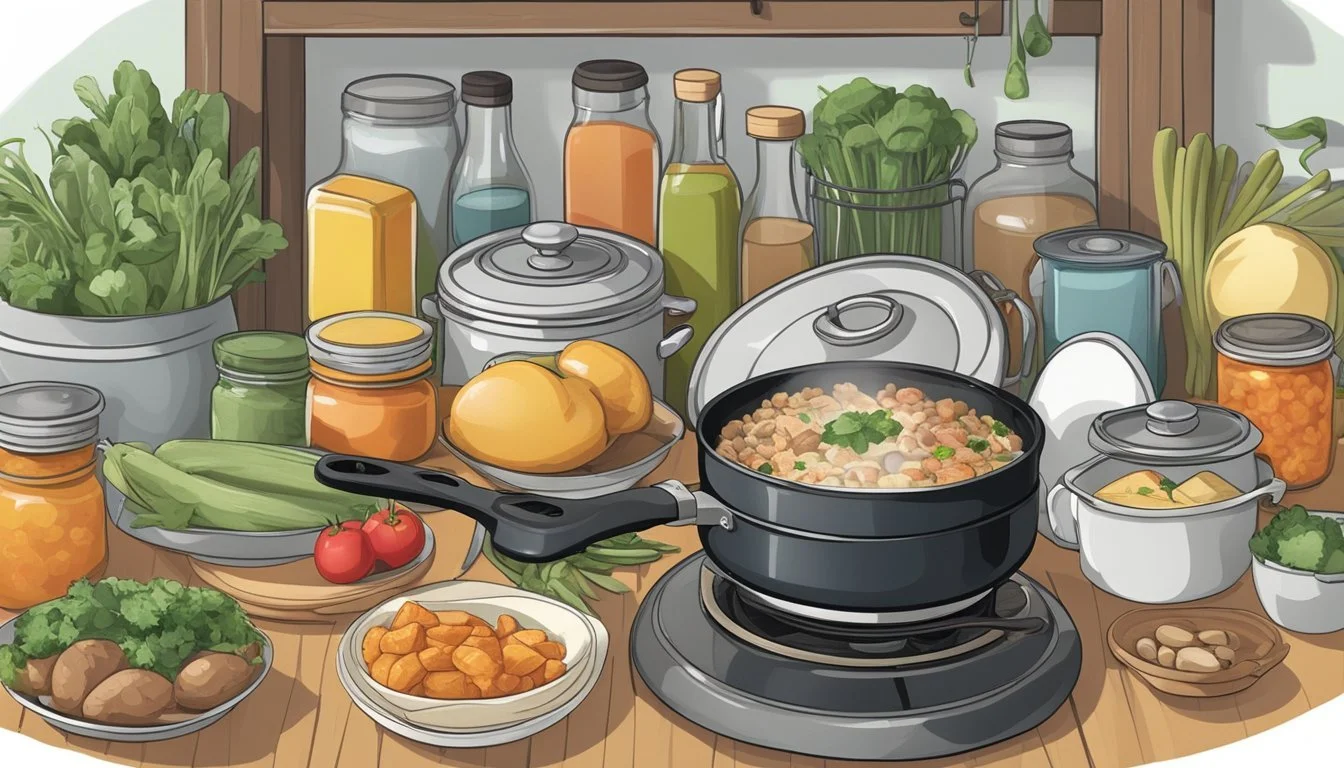Pantry-Friendly One-Skillet Meals
Quick & Easy Recipe Ideas
In the bustling rhythm of everyday life, the need for meals that are both time-efficient and satisfying is ever-present. One-skillet meals have emerged as a beloved solution for busy weeknights, bringing together simplicity and flavor in a single pan. These dishes not only streamline the cooking process but also reduce the aftermath of cleaning, making them a practical choice for those seeking convenience without sacrificing taste.
Pantry-friendly one-skillet meals take the appeal a step further by utilizing ingredients that are commonly available in the average home kitchen. From canned vegetables and beans to a variety of grains and pasta, these recipes transform everyday staples into comforting dinners with minimal effort. Moreover, by incorporating shelf-stable items, they offer the flexibility to whip up a wholesome meal even when a grocery run isn't feasible.
The versatility of one-skillet meals can accommodate a range of dietary preferences and restrictions. Proteins such as chicken, pork, or tofu provide a hearty base, while an array of vegetables adds nutritional value and color to the dish. Starches like potatoes or pre-cooked grains round out the ensemble, offering a complete and balanced meal that caters to the tastes and needs of the whole family.
Essentials of a Pantry-Friendly Skillet Meal
Creating pantry-friendly skillet meals is a blend of resourcefulness and simplicity. Utilizing long-lasting pantry staples and the versatility of a sturdy skillet, these meals are economical and convenient for busy households.
Identifying Pantry Staples
The backbone of any pantry-friendly skillet meal is a well-stocked pantry. Essential items to keep on hand include:
Grains: rice, pasta, quinoa
Canned goods: tomatoes, beans, broths
Proteins: canned tuna, dried lentils, nuts
Seasonings: salt, pepper, dried herbs, and spices
Oils: olive oil, vegetable oil
Each pantry item should be chosen for its longevity and versatility, able to be transformed into multiple meal options.
Skillet Types and Uses
Skillets come in various materials and sizes, each suitable for different meal types:
Cast Iron Skillet: Retains heat well, perfect for searing meats and baking.
Non-Stick Skillet: Ideal for sautéing vegetables and delicate proteins like fish.
Stainless Steel Skillet: Versatile for both high-heat searing and simmering sauces.
A 10-12 inch skillet is practical for most recipes, accommodating both single servings and family meals.
Benefits of One-Skillet Cooking
One-skillet meals offer numerous benefits:
Simplicity: They often require fewer ingredients and steps.
Quick Cleanup: Only one pan to wash, saving time and water.
Nutrient Retention: Cooking a meal in one pan can help retain more nutrients than using multiple cooking methods.
The skillet's ability to go from stovetop to oven expands potential recipes, from frittatas to deep-dish pizzas.
Safety and Cleaning Tips
Proper care ensures longevity and safety of the skillet:
Always let the skillet cool before cleaning to avoid warping.
For cast iron, avoid soap; instead, use coarse salt for scrubbing, then rinse and dry thoroughly.
Non-stick skillets should be cleaned with soft sponges to avoid scratching the surface.
Using heat-resistant mitts or handles when dealing with skillets is essential to prevent burns. Store skillets in a dry place to avoid rusting, especially for cast iron skillets.
Step-by-Step Cooking Guides
The following guides provide concise steps for utilizing a skillet to prepare pantry-friendly meals while emphasizing flavor and simplicity.
Basic Techniques for Skillet Use
To ensure even cooking and prevent food from sticking, always preheat the skillet before adding ingredients. For proteins like chicken, sear them on high heat to lock in moisture and flavor before reducing the heat or transferring to an oven, if necessary.
Cooking Grains and Pastas
Grains such as brown rice and quinoa, and pastas like spaghetti and linguine, form the foundation of many skillet meals. Begin by sautéing in oil to toast the grains slightly, then add a liquid such as broth or water. Simmer until the liquid is absorbed and the grains or pasta are tender.
Creating Flavorful Bases with Onions and Garlic
Sauté onions and garlic in oil until translucent to create a flavorful base for your skillet recipes. This technique releases their aromatics, which infuse the meal with depth and character.
Building Meals Around Beans and Lentils
Beans and lentils are excellent protein-rich ingredients that can be transformed into hearty skillet meals. Start by sautéing aromatics, then add the beans or lentils along with seasoning, and simmer until everything is warm and flavors are melded.
Incorporating Canned Goods Effectively
Turn to canned goods like canned tomatoes and corn to add texture and flavor without the prep. Drain and rinse beans and corn to remove excess sodium. Tomatoes can be added directly to the skillet, juice included, for a quick sauce or stew base.
Recipe Inspirations and Variations
This section provides specific ideas for creating versatile, pantry-friendly one-skillet meals that are both convenient and delicious. It emphasizes how one can use common ingredients to whip up wholesome dinners quickly, cater to meatless diets, explore global flavors, and mix and match essentials for personalized dishes.
Wholesome Weeknight Dinners
In the quest for quick and easy weeknight meals, one-skillet recipes are a treasure trove. A fan favorite is the Summer Tuscan Chicken, combining the zest of lemon juice with spinach and olive oil for a heart-healthy dinner. For a heartier dish, Skillet Shepherd’s Pie with mashed potatoes and parmesan provides a satisfying meal that can easily incorporate leftovers like carrots and peas.
Meatless Options and Alternatives
Meatless meals can be just as fulfilling, such as Lentil Soup spiked with cumin and chili for a dash of spiciness. A veggie burger skillet with black beans, bell peppers, and a tangy lime-cilantro dressing serves up a burst of flavor. For those seeking a tofu-based dish, a simple tofu scramble with tomatoes, onions, and seasonings like paprika and onion powder can replicate the savoriness of scrambled eggs.
Customizable Ingredient Combinations
The beauty of one-skillet meals lies in their flexibility. Burrito bowls can alternate between rice or quinoa, paired with flavorful tomatoes, cheese, and canned salmon or leftover chicken. For a quick lunch, quesadillas with a filling of cheese, leftover meatballs, or even flaked salmon can be assembled and cooked in minutes.
International Cuisine Adaptations
One-skillet meals can transport diners around the globe. A classic Chicken Florentine melds unsalted butter with olive oil, spinach, and parmesan for an Italian-inspired feast. Alternatively, bring the taste of Mexico to your kitchen with flavorful chili, sweet bell peppers, and spices for a homemade skillet quesadilla infused with robust seasonings.
Advanced Skillet Techniques
Elevating one's skillet meals requires finesse with heat management and ingredient interplay. These techniques will guide one to achieve complex flavors and textures that distinguish amateur skillet cooking from culinary mastery.
Mastering the Sear and Simmer
To maximize flavor, one must first sear the ingredient—often protein, like chicken—to develop a golden crust. The high heat of the skillet causes the Maillard reaction, creating rich savory notes. Post-sear, simmering with ingredients like garlic allows flavors to meld, while the protein becomes juicy and infused with the essence of the accompanying aromatics.
Executing Perfect Reductions and Caramelization
A skillet is the ideal vessel for reductions and caramelization. One can simmer sauces until they thicken, intensifying flavor and clinging to ingredients for a robust dish. Vegetables like onions, when patiently cooked, undergo caramelization, transforming their natural sugars into a deep, sweet complexity that enhances the meal's overall savoriness.
Cooking with Alcohol
Incorporating alcohol into a skillet recipe does more than just add flavor. Alcohol can deglaze a pan, lifting the fond (cooked-on bits) for a rich sauce base. The alcohol should be allowed to cook off to mellow its sharpness, leaving behind a nuanced taste profile that can complement the primary ingredients beautifully.
Layering Flavors
The art of layering flavors is crucial and can be achieved by adding ingredients at specific stages. One starts with a base—perhaps onions and garlic, then builds with herbs, spices, and main ingredients, allowing each to impart its profile to the collective dish. The skillet's consistent heat aids in melding these together for a harmonious and multi-dimensional final product.
Accessorizing Your Meal
Enhancing one-skillet meals involves incorporating complementary breads and sides for a more rounded experience, as well as applying garnishes for final touches that boost both flavor and presentation.
Pairing with Breads and Sides
One can substantially elevate a skillet meal by selecting the right kind of bread. A crusty baguette or ciabatta serves as an excellent vessel for sopping up savory juices, while flatbreads or tortillas work well for wrapping around the meal's ingredients. For sides, consider quick-cooking grains like couscous or quinoa, which not only absorb the dish's flavors but also add a satisfying texture.
Breads to Consider:
Baguette
Ciabatta
Tortillas
Sides Suggestions:
Couscous
Quinoa
Garnishes and Final Touches
Garnishes are not merely decorative; they can be pivotal in defining the final flavor profile of a dish. A sprinkle of bold spices, a drizzle of high-quality olive oil, or a scattering of fresh herbs can intensify the taste. Adding cheese adds richness and depth, while a dollop of sour cream can balance spicy notes with its cool creaminess. One should be both deliberate and creative with these additions to achieve the desired taste and aesthetic.
Garnish Ideas:
Fresh herbs (e.g., parsley, cilantro)
Spices (e.g., smoked paprika, red chili flakes)
Final Touches:
Cheese (shredded or crumbled)
Olive oil (a final drizzle)
Sour cream (a spoonful for creaminess)
Food Safety and Storage
Managing food safety and storage is crucial for pantry-friendly one-skillet meals, ensuring that leftovers are safe to consume and ingredients maintain their quality. The reader must be aware of the longevity of leftovers, optimal storage methods, and safe practices for freezing and reheating to prevent foodborne illnesses.
Understanding Leftover Lifespan
Pantry Meals: After preparation, meals should be stored in the refrigerator within two hours to prevent the growth of bacteria. Leftovers typically last:
3-4 days for meat-based dishes
1-2 days for seafood dishes
5-7 days for vegetarian dishes (What wine goes well with vegetarian dishes?)
Skillet Meals: Due to their varied ingredients, it's important to consider the shortest lifespan among the ingredients used.
Best Practices for Food Storage
Containers: Use airtight containers to keep leftovers fresh and prevent contamination.
Temperature: Refrigerate at or below 40°F (4°C) and freeze at or below 0°F (-18°C).
Labeling: Clearly label leftovers with the date they were made to track their lifespan.
Tips for Freezing and Reheating
Freezing:
Cooling: Cool leftovers before freezing to maintain food safety.
Portioning: Divide into appropriate portions for easy defrosting.
Reheating:
Temperature: Reheat to at least 165°F (74°C) to ensure harmful bacteria are killed.
Method: Use an oven, stove, or microwave for even heating and check the internal temperature with a food thermometer.
Kitchen Tips and Tricks
Efficient use of time and resources is crucial for busy families and home chefs. This section provides practical advice on streamlining the cooking process and minimizing the post-cooking cleanup.
Efficient Cleanup and Maintenance
For those who dread the post-meal cleanup, non-stick skillets and silicone utensils are indispensable. They help to ensure that food releases easily, reducing the need for scrubbing. After cooking, a quick wipe with a damp paper towel can remove most residues. To maintain the skillet’s condition, ensure it is thoroughly dry before storing to prevent rust and degradation.
Multi-Tasking with a Single Skillet
A single skillet on the stovetop is a versatile tool capable of both searing and simmering. Home cooks can sauté vegetables, brown meats, and create sauces all in one pan. By carefully timing each addition, they optimize flavor development while ensuring everything cooks to perfection. Here, efficiency is key—prepare all ingredients beforehand for seamless execution.
Ingredient Substitutions
At times, certain recipe items might be unavailable. Home chefs shouldn't hesitate to swap similar ingredients. For instance:
Broths for water: Enhance flavors by cooking rice or grains in vegetable or chicken broth.
Frozen for fresh: Vegetables can be interchanged easily; frozen peas or corn are excellent stand-ins for their fresh counterparts.
Spices and herbs: If a recipe calls for fresh herbs and none are on hand, dried versions can work. Just remember, dried are more potent so one should use them sparingly.
By mastering these tips and tricks, families can enjoy homemade meals with fewer dishes to wash and more time to spend together.
Additional Cooking Equipment
When diversifying one-skillet meals, the savvy cook can incorporate various additional cooking tools to expand their culinary repertoire. From sheet pans to slow cookers, each equipment brings unique benefits that can complement the central role of the skillet.
Using a Sheet Pan for Support
Sheet pans are excellent for assisting the primary skillet when preparing meals. For instance:
A chef can roast a medley of favorite veggies on a sheet pan in the oven, while simultaneously searing chicken in the skillet.
Sheet pans offer uniform heat distribution, making them ideal for cooking large batches of food that might not fit in a skillet.
Slow Cooker Companions
Slow cookers serve as a convenient ally in the kitchen that can transform tough cuts of meat into tender delicacies. They are particularly useful when used in conjunction with a skillet:
Slow Cooker: Braise meats or simmer stews low and slow.
Skillet: Use it afterwards to sauté aromatics or create a quick pan sauce based on the concentrated flavors from the slow cooker.
Non-Stick Skillet Advantages
A large non-stick skillet is a cornerstone in one-pan meal preparation. Its key benefits include:
Easy Cleaning: Non-stick surfaces mean less scrubbing and quick turnaround between dishes.
Healthy Cooking: Requires less oil, enabling lighter versions of recipes.
Conclusion
One-skillet meals provide an efficient solution for busy weeknights, combining simplicity, nutrition, and cost-effectiveness. They empower cooks to make the most of pantry staples, leading to less food waste and more creativity in the kitchen.
These meals often incorporate a balance of protein, vegetables, and starch, creating a well-rounded dish. Whether one opts for chicken, beef, tofu, or a combination of vegetables, these ingredients form the foundation of a hearty meal. Pairing the protein with uniformly chopped vegetables ensures even cooking. Starches like potatoes, pasta, or grains like quinoa add substance to the skillet, making the dish satisfying.
For those seeking to minimize kitchen time without sacrificing taste, one-skillet recipes are a valuable resource. They often require minimal cleanup, as they consolidate cooking to a single piece of cookware. The versatility of such meals also allows for adaptation based on available ingredients, making them particularly useful for end-of-week cooking when supplies may be dwindling.
One-skillet meals are not just a practical choice but also a canvas for culinary exploration. With a variety of ingredients that can be adjusted based on personal preference or dietary requirements, each skillet meal can be a unique and flavorful experience. They stand as an essential component of a home cook's repertoire, deserving regular inclusion in meal planning for individuals and families alike.








